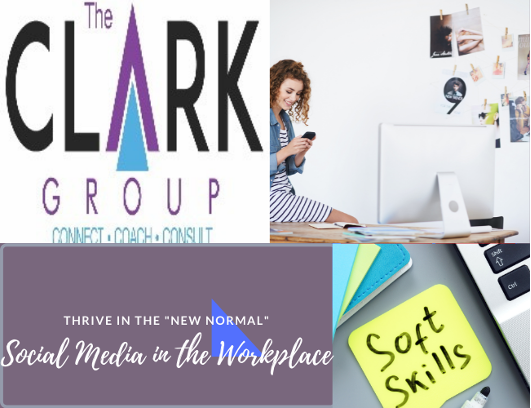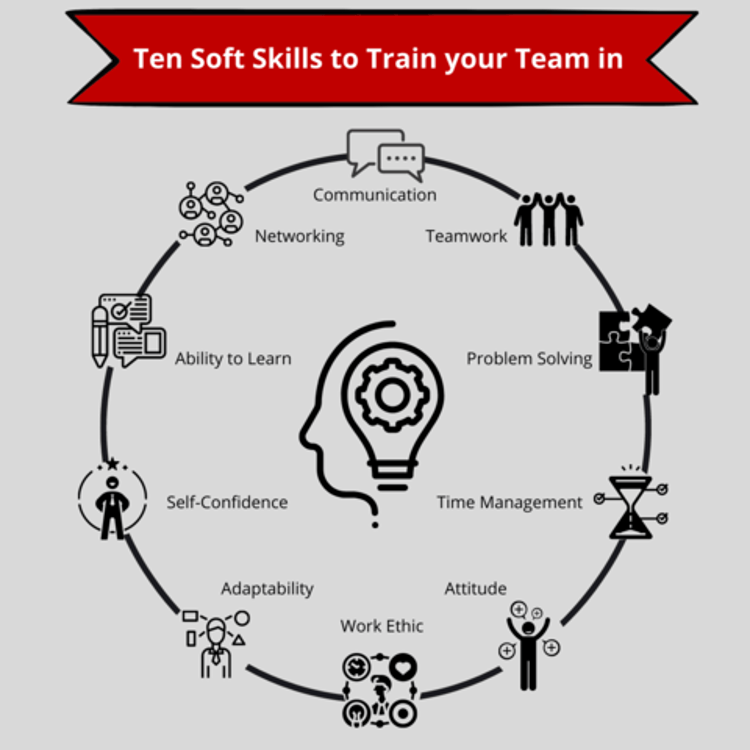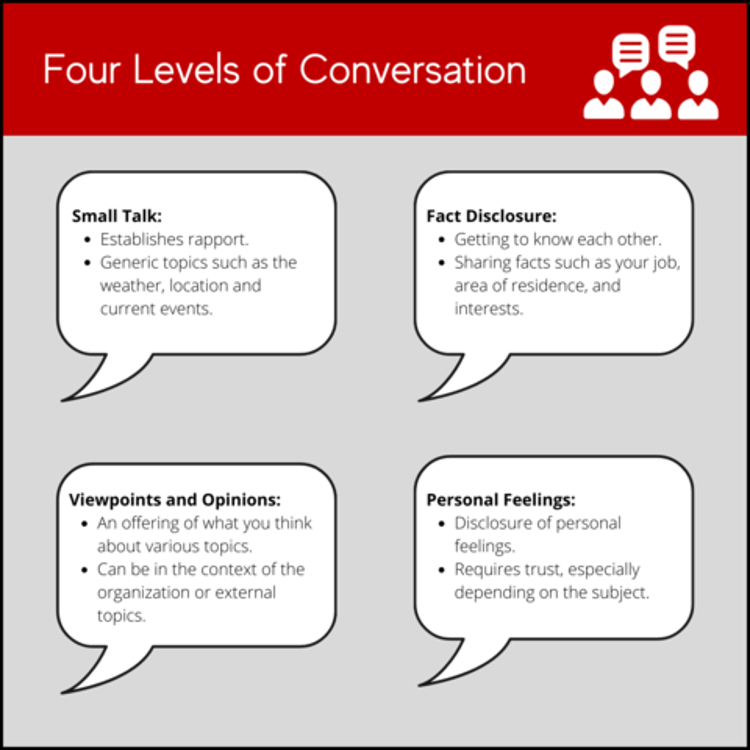MOVE UP THE SUCCESS LADDER WITH SOFT SKILLS TRAINING
Soft skills are a crucial part of what makes a strong employee in any organization. Soft skills impact how we communicate with colleagues, problem-solve, and are a contributing factor to the long-term success of your organization. After extensive research, psychologist and author Dan Goleman concluded in his book Emotional Intelligence at Work that when IQ and technical skills are similar, soft skills such as emotional intelligence account for 90% of what makes people move up the success ladder. Below are our top ten Soft Skills you should be training your team in to boost their personal and professional development
1. COMMUNICATION
Communicate Skills Training can increase efficiency and productivity within your organization, leading to more constructive interactions. The first thing that we typically associate with communication is spoken and written words. But the words we speak and hear are just one way to communicate, and some studies show that communication takes place in a variety different of ways:
· Nonverbal communication: Communication without words, such as eye contact or posture
· Verbal communication: Communication with words, both written and spoken
· Body language: Communication through gestures, personal space, and touching
Being able to participate in two-way communication will allow you to complete tasks more efficiently and build better relationships.
2. TEAMWORK
Working with others is an inevitable part of being in an organization. Building teams that can complete tasks efficiently and accurately can be challenging but having teams with diverse sets of hard and soft skills will ensure that there are a variety of outlooks when decisions need to be made. There are some basic techniques you can use when working in a team to help create a cohesive unit that leverages everyone’s talents.
Employees with good teamwork skills can work well with others to achieve a common goal. Teams face a unique set of challenges in the digital age, but good teamwork can still take place and contribute to meeting objectives more effectively than individually.
According to the Harvard Business Review, the highest performing teams have these four components in common.
· Compelling direction: Having established goals that are challenging but achievable will motivate teams to meet objectives.
· Strong Structure: Having a team with a balanced set of skills and diverse views/backgrounds encourages creativity.
· Supportive context: Ensuring the team has everything they need to effectively communicate and work towards their objectives together. This is especially important in the increase of digital teamwork.
· Shared mindset: Having a common understanding to promote better collaboration.
Furthermore, evaluating the effectiveness of your team’s ability to collaborate can help you determine how to improve your team building for future projects.
3. PROBLEM-SOLVING
No matter what your industry or your role we all solve big or small problems every day. Having the ability to apply problem-solving skills helps not only to enhance productivity, but also helps to cultivate positive relationships by focusing on shared goals and solutions.
An important part of problem-solving is being able to identify and define problems clearly. Don’t be afraid to speak up when you notice negative patterns in your organization that could be resolved. Being able to effectively problem solve is a transferable skill you can bring to any role or organization. When problem-solving, be sure to generate a variety of alternative and creative solutions so you can move forward with the most ideal option. Once this is implemented you can evaluate how effectively the problem was solved and use that knowledge to better your problem-solving skills going forward.
4. TIME MANAGEMENT
The ability to effectively manage your time is key to productivity. While we all have the same number of hours in a day, our time management skills determine how we make the most out of our time. Taking a moment at the start of your day to determine what is most important, whether in terms of value or completion, will help you better prioritize your tasks. Setting priorities helps ensure that you take care of the things that are most pressing, or which deliver the most value. Scheduling out time blocks for your tasks can also ensure you allocate enough time to complete all your tasks.
Furthermore, noticing and determining your distractions can help you brainstorm solutions to better manage them. Another time management tip growing in popularity is ditching multitasking. Studies have shown that 30-40% more time is spent when you multitask rather than when your mono-task (work on one thing at a time). Multitasking also means your attention is divided, which can lead to miscommunication and errors.
5. ATTITUDE
Being able to maintain a positive attitude not only benefits your organization, but also impacts your productivity and your workplace happiness. People who have a consistently positive attitude can build more effective workplace relationships and breeds resilience when faced with challenges or setbacks.
A positive attitude in the workplace can be fostered by practicing gratitude. Seeing our work and what it provides us in terms of satisfaction, contentment, excitement, and other nonmaterial benefits. Finding ways to love the work you do sets you up for increased professional and personal happiness. Having a positive attitude allows you to build better trust with your colleagues and will make you a more valuable employee.
6. WORK ETHIC
A solid work ethic can also help you find reward in the work you do and shows a dedication not just to goals and outcomes but to your overall professional development. A strong work ethic will contribute to relationships with teammates and superiors.
Having clear goals will allow you to have a strong work ethic towards what you are working for and fully invest in a project or in developing your skills. Take time to clarify what your personal goals are, both in terms of specific projects and your overall career. Set specific goals and then create plans to achieve them. Tie these goals to your day-to-day tasks and responsibilities so that you can keep them in mind.
7. ADAPTABILITY
The ability to effectively respond to changing situations and needs is key to success in the fast-paced workplaces most of us find ourselves in. Change can be intimidating, but learning to adapt is a crucial skill in the workplace.
Showcasing your adaptability at work increases your value in your organization. Some examples of demonstrating flexibility in your organization include:
· Being open to alternative solutions
· Taking on new roles
· Help others generate alternative solutions or plans
· Accepting unexpected changes
· Keeping calm in fast-moving or stressful situations
· Demonstrating confidence in your ability to complete the jobs that require flexibility
8. SELF-CONFIDENCE
Demonstrating self-confidence and the belief that you can handle what comes your way establishes trust with your team. When you show confidence, you make others around you feel confident too. Confidence is not arrogance, but rather a trust in your judgment and abilities. There are many common traits to keep in mind when building your self-confidence. Being willing to listen to other’s ideas, and not be afraid to ask questions or be wrong shows a willingness to learn without fear of looking silly. It also means acknowledging mistakes and learning from them. Employees with self-confidence also follow through on things that are said and promised. Being self-aware of what you are capable of and when you may need to ask for help also demonstrates confidence. While self-confidence in the workplace can take time, it is a highly worthy skill to focus on and train your team in.
9. ABILITY TO LEARN
Self-Confidence falls closely under the ability to learn and accept criticism. Taking criticism can be hard sometimes, but it is a crucial part of professional and personal development. Accepting criticism shows commitment to your growth and increases your value in an organization over time.
By remembering that criticism is offered with a positive intention, we can focus on how it will help us improve. When someone offers you feedback or criticism, listen with an open mind and reflect back to clarify your understanding. Feedback can be analyzed with the help of a third party such as a mentor, to better determine how to proceed with it.
10. NETWORKING
Taking the time to network and build relationships is a key soft skill that expands your professional circle of connections. Networking can happen both within a company and outside your company, and builds mutually beneficial relationships, allowing us to learn from one another.
When taking opportunities to network, ask questions about their current role and organization, along with their overall professional goals and interests. Beyond thinking of how your networks can be beneficial to you, have confidence in what you have to offer to create a strong, powerful network.
Networking can be done in a variety of formats, from a designated event to conferences and of course LinkedIn. No matter the format, you will utilize various soft skills – active listening, self-confidence, and a positive attitude – as you network.
CONCLUSION
These Soft Skills are all covered in our 10 Soft Skills You Need Workshop. Get everything you need to deliver training on virtually any soft skills topic with our Soft Skills Library.
CONCLUSION
Leadership training can not only benefit the managers and supervisors on your team but can be beneficial to anyone as it encourages taking charge and being proactive in any corporate role. Build on your team’s leadership skills with our various training workshops on Leadership and Influence and Servant Leadership. Get started on your corporate training with one of our popular product packages or select individual courses.
See our course catalog below
ONLINE COURSES OFFERED BY PRODUCT BUNDLES
ONLINE COURSES OFFERED BY INDIVIDUAL COURSES
LEVEL-UP YOUR SKILLS TODAY
Individual Online Courses
- 24/7 All-Access to all course curriculum for 12 months from purchase date.
- Obtain Certificate of Completion for each course.
- You can start and stop on your own time.
- Video training in your home!



Want more information?
Contact Info
All Rights Reserved | The Clark Group



